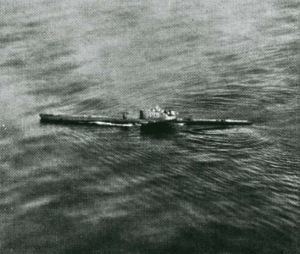The Rubis (H4, 202, P15) was a Saphir-class minelaying submarine which served in the French Navy and Free French Navy during the Second World War. She was awarded the Ordre de la Libération for her services.
After serving in Toulon with the 7th and later 5th Submarine Squadrons, in 1937 Rubis was transferred to Cherbourg.
During the Norwegian campaign, in May 1940, she laid mines off the Norwegian coast; her mines claimed four Norwegian vessels in May and June, and a further three merchantmen in July. At the time of the French surrender on June 22, 1940, she was in the port of Dundee, Scotland in the United Kingdom, where she promptly joined the Free French Forces. At that time, she was commanded by Capitaine de Corvette Georges Cabanier.
Whilst minelaying off Norway in mid-1941, she encountered and torpedoed a Finnish merchantman. Later in the war, she laid mines in the Bay of Biscay, claiming three German auxiliary minesweepers, an armed trawler, and a Vichy French tug in 1942, and a fourth auxiliary minesweeper in 1943. Operating off Stavanger in September 1944, her mines claimed two auxiliary submarine chasers and two merchantmen. In October and November, she continued in Norwegian waters, damaging but not sinking two vessels. On 21 December, however, her mines claimed three auxiliary submarine chasers, a German merchantman, and a minesweeper.
Throughout the war, Rubis made 22 operational patrols, laying nearly 683 mines and sinking some 21,000 GRT of shipping. With 22 ships sunk (14 of them German, including 12 warships), she achieved the highest kill number in the FNFL.
From 1946 to 1948, she was used as a school ship for rigging in Toulon.
Rubis was struck on 4 October 1949, and was sunk on 31 January 1958 to be used as a sonar target. The wreck lies 41 metres underwater between Cavalaire and Saint-Tropez, and has become a popular diving attraction.
26 May 1940: Norwegian transport Vansø (54 BRT) hits a mine laid on 10 May and sinks at 58°21′00″N 06°01′00″E
28 May 1940: Norwegian sail ship Blaamannen (174 BRT), from Haugesund, hits a mine laid on 27 May and sinks at 59°28′00″N 05°12′00″E
31 May 1940: Norwegian merchantman Jadarland (938 BRT), from Haugesund, hits a mine laid on 27 May and sinks at 59°28′00″N 05°12′00″E
10 June 1940: Norwegian merchantman Sverre Sigurdssøn (1 081 BRT) hits a mine laid on 9 June off Herdla and sinks at 60°36′00″N 04°55′00″E
7 July 1940: Norwegian merchantman Almora (2 433 BRT), from Egersund, hits a mine laid on 10 May at 58°21′00″N 06°01′00″E. The ship survives.
24 July 1940: Norwegian merchantman Kem (1 705 BRT), from Egersund, hits a mine laid on 10 May and sinks at 58°21′00″N 06°01′00″E.
28 July 1940: Norwegian merchantman Argo (413 BRT), from Egersund, hits a mine laid on 10 May and sinks at 58°21′00″N 06°01′00″E.
21 August 1941: Rubis torpedoes and sinks the Finnish merchantman Hogland (4 360 BRT) off Norway at 58°27′00″N 05°46′00″E.
12 June 1942: German auxiliary minesweeper M 4212 (formerly Marie Frans), 125 BRT, hits a mine laid on 5 June and sinks at 43°37′00″N 01°34′00″W.
26 June 1942: Vichy French tugboat Quand Même (288 BRT) hits a mine laid on 5 June and sinks at 43°37′00″N 01°35′00″W.
10 July 1942: German auxiliary minesweeper M 4401 (formerly Imbrin), 339 BRT, hits a mine and sinks at 44°58′00″N 01°23′00″W.
18 August 1942: German Vorpostenboot V 406 (formerly Hans Loh), 464 BRT, hits a mine laid on 14 August and sinks at 45°03′00″N 01°34′00″W.
20 September 1942: German auxiliary minesweeper M 4448 (formerly: L 4148), 77 BRT, hits a mine laid on 5 June and sinks at 43°37′00″N 01°34′00″W.
10 July 1943: German auxiliary minesweeper M 4451 (formerly Gauleiter A. Meyer), 652 BRT, hits a mine off Arcachon and sinks at 44°58′00″N 01°10′00″W.
26 September 1944: German auxiliary submarine hunter UJ 1106 (formerly Grönland), 464 BRT, hits a mine laid on 24 September and sinks at 58°45′00″N 05°24′00″E.
27 September 1944:
German auxiliary submarine hunter UJ 1715 (formerly Lesum), 464 BRT, hits a mine laid on 24 September and sinks at 58°45′00″N 05°24′00″E
German merchantman Cläre Hugo Stinnes (5 295 BRT) hits a mine laid on 24 September and sinks at 58°45′00″N 05°24′00″E
Norwegian cargo ship Knute Nelson (5 749 BRT) hits a mine laid on 24 September and sinks at 58°45′00″N 05°24′00″E
27 October 1944: German Vorpostenboot V 5304 (formerly Seehund) hits a mine laid on 18 October at 60°55′00″N 04°40′00″E. The ship survives with heavy damage.
24 November 1944: Norwegian merchantman Castor (1 683 BRT), from Egersund, hits a mine laid on the same day and sustain damage.
21 December 1944, off Norway:
German cargo ship Weichselland (formerly Latvian Gundega), 3 654 BRT, hits a mine laid on 19 December and sinks
German auxiliary submarine hunter UJ 1113 / KUJ 7, 970 BRT, hits a mine laid on 19 December and sinks
German auxiliary submarine hunter UJ 1116 / KUJ 11, 970 BRT, hits a mine laid on 19 December and sinks
German auxiliary submarine hunter UJ 1702 / KUJ 16, 970 BRT, hits a mine laid on 19 December and sinks
German minesweeper R 402, 140 t, hits a mine laid on 19 December and sinks

